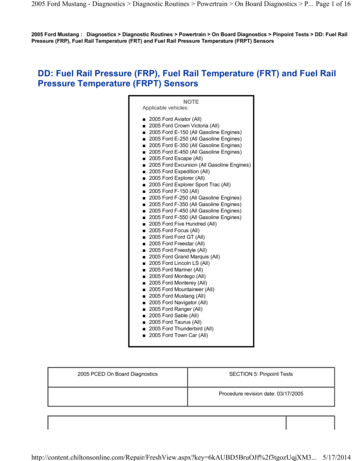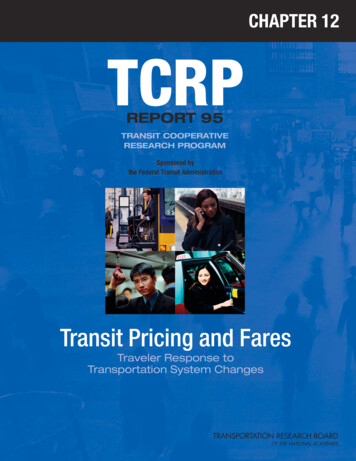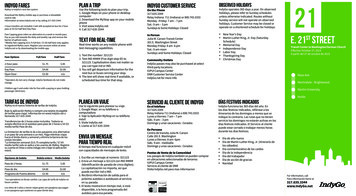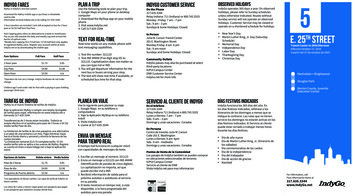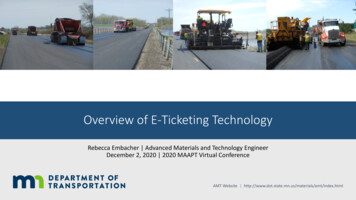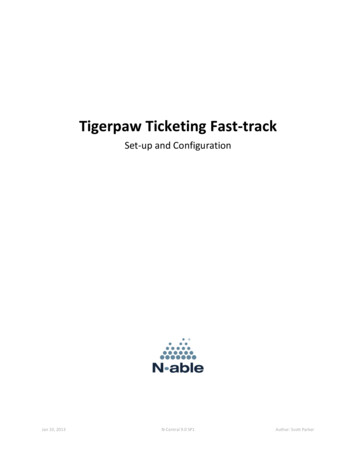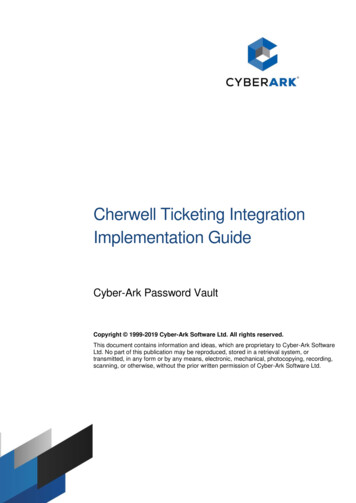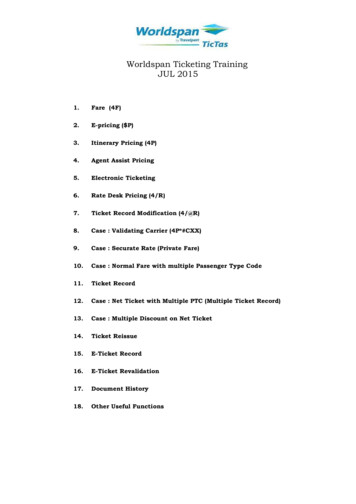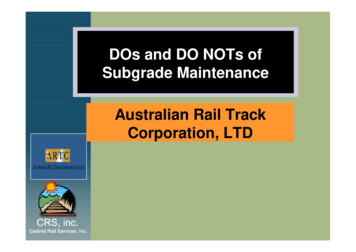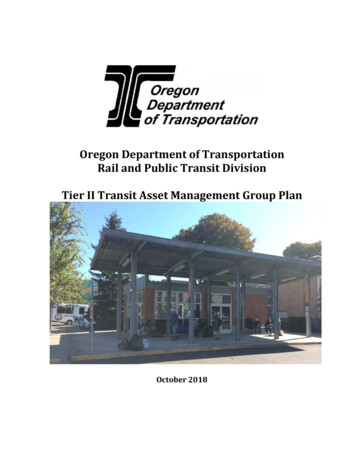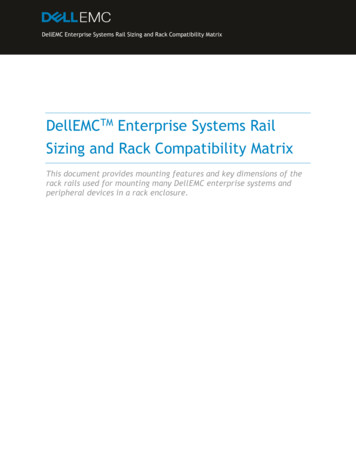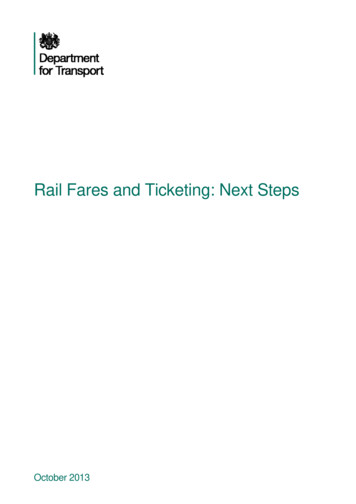
Transcription
Do n Do not remove this if sending to pagerunnerr Page TitleRail Fares and Ticketing: Next StepsOctober 2013
The Department for Transport has actively considered the needs of blind andpartially sighted people in accessing this document. The text will be madeavailable in full on the Department’s website. The text may be freelydownloaded and translated by individuals or organisations for conversion intoother accessible formats. If you have other needs in this regard please contactthe Department.Department for TransportGreat Minster House33 Horseferry RoadLondon SW1P 4DRTelephone 0300 330 3000Website www.gov.uk/dft Crown copyright 2013Copyright in the typographical arrangement rests with the Crown.You may re-use this information (not including logos or third-party material) freeof charge in any format or medium, under the terms of the Open GovernmentLicence v2.0. To view this licence, overnment-licence/version/2or write to the Information Policy Team, The National Archives, Kew,London TW9 4DU, or e-mail: psi@nationalarchives.gsi.gov.uk.Where we have identified any third-party copyright information you will need toobtain permission from the copyright holders concerned.
ContentsForeword . 4Executive Summary . 6A better deal on fares . 6Improving current ticketing. 7Building the smart ticketing system for the future . 81.Introduction . 9Government's wider strategy for Rail . 9What the review has sought to achieve and why . 10The key principles underpinning the review . 11The structure of this report. 12Further information about fares and ticketing. 122.A better deal on fares . 14Introduction . 15Ending extreme fare rises . 16A better deal for commuters. 17A better deal for longer-distance passengers . 24Balancing complexity and choice. 28Advance fares – a rail success story . 303.Improving current ticketing . 33Introduction . 34Government's role. 34Key ticketing principles . 35A changing landscape . 36What needs to change? . 37Rail ticketing in a modern consumer market . 39What Government is doing . 43Further improvements to ticketing. 504.Building the smart ticketing system of the future . 58Introduction . 59Future technologies . 59Our vision for the future . 63Delivering our vision . 645.Conclusion . 71Annex 1. Terms of Reference. 72Annex 2. Summary of Consultation responses. 733
ForewordOur railways are a vital part of our nation’s future. The Coalition Government isdetermined to build on the continued success of our railways and that is why weare providing over 16 billion over the next five years to support the networkand make sure it can respond to increasing passenger demand, help economicgrowth and cut our carbon footprint.But new track and trains are only part of the story for improving our railways.We remain committed to rolling out smart ticketing across the network. We wantthe whole experience of travelling by rail to be modern, seamless and easy,starting with buying a ticket to travel. We also recognise that the cost andcomplexity of train fares is naturally a key concern for passengers.That is why we have carried out a review of rail fares and ticketing andconsidered a range of options to address the many issues raised by passengersand others. Today I am setting out our vision for a modern, customer-focusedfares and ticketing system that will support our objectives of allowing even morepeople to travel by rail and ensure they have a better experience and which: supports a passenger-focused railway, meeting changing needs andtravel patterns; promotes a vibrant future for our railways supporting economicgrowth and prosperity and helping to reduce the country’s carbonfootprint; enjoys the trust of passengers and the commitment of the railindustry; and maintains its current strengths whilst embracing sensible change inthe interest of passengers and taxpayers who fund our railways.We know that for many passengers it is the cost of some fares that remains theoverriding concern. Responsible stewardship of the railways means bearingdown on running costs and investing in a sustainable way and that is ourpriority. To help passengers, I can confirm that from January 2014 we will giverail passengers a better deal by capping the upper limit of any individual farerise at 2% above the permitted average of inflation plus 1%, for all regulatedfares. This will protect passengers from large fare increases which can have asignificant impact on household budgets by taking 3% off the maximumincrease for a regulated fare.And while the above-inflation fare rises of recent years have been necessary tohelp fund our record investment in the network, it remains our firm ambition tocap fare rises at the level of inflation, just as soon as economic conditions allowand savings have been made to the cost of running our railways.
This rail fares and ticketing strategy sets out the other actions we will take to: give passengers a better, more modern and more flexible deal onfares; improve the current ticketing system while in parallel building thesmart ticketing system of the future; and encourage innovation and efficiency from train companies for thebenefit of the passengers and taxpayers alike.It explains how we will blend the best of regulation with the best of marketforces to deliver a fares and ticketing system that puts passengers first and ourrailways on a sustainable footing for the future.I would also like to thank stakeholders for their many contributions to thisreview, notably those from the Rail Delivery Group, the Association of TrainOperating Companies, Passenger Focus and London TravelWatch.The Right Honourable Patrick McLoughlin MPSecretary of State for Transport5
Executive Summary1.The Coalition Government is committed to its vision of a high performingrail network that keeps cities moving and communities connected at anacceptable cost to the taxpayer and the passenger2.To support this vision, we have pledged over 16 billion of support forthe rail industry over the period to 2019 in order to improve the capacityand quality of a network which is seeing a vast growth in demand.3.Our goal for rail fares and ticketing is to allow more passengers to traveland to have a better experience of rail, at the same time bringing downindustry costs and costs to the taxpayer.4.Following a consultation on rail fares and ticketing to inform this reviewwe now set out our plans to secure passengers the best deals on fares,to improve current ticketing practices and to ensure that we build thesmart ticketing system for the future for the benefit of passengers, whilstensuring that the impact to the taxpayer is kept at a minimumA better deal on fares5.We know that rail fares and the complexity of the fares structure are aconcern to rail passengers.6.To reduce the impact of fares increases on passengers and improve theoverall quality of the fares packages on offer to them, we will be: Reducing the current fares flex from 5% to 2%, thereby limiting theextent of the annual fares increases and putting money back intothe hands of passengers. Trialling a scheme to regulate longer distance off peak tickets on asingle leg basis to remove the confusing scenario where somesingle off-peak tickets cost nearly as much as return tickets, and toalso to offer passengers increased choice and flexibility. Trialling more flexible tickets that can provide a more attractiveoffer for commuters travelling fewer than five days a week, oroutside peak hours, that can better match more modern workingpatterns and potentially help to better manage capacity on therailways.7.In doing the above, we are simplifying the fares package available topassengers to enable cheaper and more flexible journey choices. Weare looking to cater to the variety and diversity of modern travel patterns,6
we are reducing the impacts of fares rises on passengers and aresetting the groundwork for our future ambitions.Improving current ticketing8.Ticketing is an integral part of a passenger’s interaction with the railnetwork. The Coalition Government is committed to ensuring thatpassengers have access to the right information that will help themmake the best decisions regarding which tickets best suit their needsand making sure they have access to the most relevant and up to dateinformation regarding their journey.9.Technological advances and a better understanding of rail passengers’needs mean that we can now offer them an improved and more modernticketing service akin to those that they are becoming accustomed to inother industries whilst, at the same time, making the railways moreefficient and saving on current costs of operating the network.10.We are keen to see more investment and innovation from train operatingcompanies to reflect a shift towards more efficient forms of ticketing suchas better “self-service” ticket machines, websites and mobileapplications. However, we are clear that any such changes beingproposed by operators must also have appropriate safeguards so thatthey are in the overall best interest of passengers.11.We will be working closely with the Office of Rail Regulation, trainoperators and other stakeholders to bring about changes that willincrease transparency, remove confusion and help passengers feelconfident about their ticket purchases and to fully understand the termsof their use.12.The actions arising from this review that will bring about such changesare: A Code of Practice on ticketing information that will ensurepassengers can access the information they need to confidentlyselect the most appropriate ticket for their journey;An improved approach to the way we manage approvals forchanges to ticket offices with incentives for train companies tomodernise ticketing facilities, while providing appropriatesafeguards for passengers – including being able to get help andadvice from a member of staff, where they can do so now;A stronger and more focused approach to quality and customerservice in franchises including ticket retail;A market review by the Office of Rail Regulation to considerwhether the current market for selling train tickets is operating asefficiently as possible;Publication of annual “mystery shopper” surveys of all retailchannels to improve transparency for passengers;Supporting further steps by the rail industry to improve ticketing.7
13.The measures above will significantly improve the ticketing experience,ensuring that the needs of rail passengers of all types continue to becatered for. It will also enable the network to operate more efficientlydriving savings for train operators and taxpayers.Building the smart ticketing system for the future14.The Government wants to ensure that the benefits of new ticketingoptions now being made available through advances in technology areexploited and passed on to passengers at the same time as maximisingopportunities to reduce costs and increase the productivity and efficiencyof the railway. The proper application of technological advances can notonly reduce costs to passengers and taxpayers but can also drive animprovement to the overall quality of passengers’ experience at allpoints of interaction between them and the rail system; right from whenthey buy their tickets through to completion of their journeys.15.Smart ticketing presents a particular opportunity to provide passengerswith faster, simpler and more flexible ticketing systems - we want to usesmart ticketing technologies to introduce new ticket types currentlyunavailable due to limitations in current magnetic stripe systems. Thiswill provide passengers with tickets better suited to their travellingpatterns and save them money.16.We have already seen the benefits of using smart ticketing in Londonthrough TfL’s Oyster system and have plans to roll out smart ticketingacross the rail network. Our plans can be divided into three broadphases:1. We will deliver our South East Flexible Ticketing (SEFT)Programme, outputs from which will help inform our future smartticketing strategy.2. Subject to the success of SEFT and future funding, we will runfurther such targeted delivery programmes, likely to be based oncities outside London with a significant rail commuter base, from2015-16;3. To complete the smart enablement of the entire networkFinally we will complete our plans with the withdrawal of magnetic ticketswithin the next 10-15 years and start to see the full potential andefficiencies possible from using smart technologies realised.17.Throughout our programme of delivery we will be facilitating cooperation between Government, train operators, local authorities, andother stakeholders to make sure that we deliver a well integrated systemthat is consistent across the network without hampering innovation andensuring the system is sustainable and sensitive to future technologicaldevelopments.8
1. IntroductionThis chapter sets out: how this strategy fits into Government’s wider strategy for rail; what Government is seeking to achieve and why; the key principles underpinning it; the structure of this document.Government's wider strategy for Rail1.2This Government’s vision is for a rail network that keeps cities movingand communities connected at an acceptable cost to the taxpayer, andensures passengers benefit from a high-performing, affordable railway.1.3More passengers are now using our railways than at any time since the1920s, on a network that is half the size. Passenger journeys havedoubled over the last twenty years 1 and demand is forecast to grow bya further 16% between 2013/2014 and 2018/2019 2 . In response to thissuccess, Government seeks to accommodate an increase in rail travelwhere practical and affordable, by providing for extra capacity, and byadopting new technologies and more efficient operating practices.1.4To support this vision we are providing an unprecedented 16 billion tosupport the network and equip it to respond to increasing passengerdemand over the next five years, including funding major improvementsto reduce overcrowding 3 . On top of this, we are also committed toinvesting in the High Speed 2 rail network to bring the UK’s railwayinfrastructure dramatically into the 21st century, releasing space oncrowded lines and bringing the whole country closer together.1.5But this investment – and the day to day operation and maintenance ofthe network – comes at a considerable financial cost. In 2011/12 inEngland passengers funded the cost of running our railways to the tune1Passenger Journey Numbers are tem/uploads/attachment data/file/49871/rai0101.xls2Statement of Funds Available and High Level Output Specification (2012) available -and-improving-the-rail-network3High Level Output Specification (2012) available -and-improving-the-rail-network9
of 6.7 billion through fares, while taxpayers contributed 3 billion (otherrevenue sources e.g. station retail accounting for 1.2 billion) 4.1.6As the independent Rail Value for Money Report (2011) 5 showed, bothpassengers and taxpayers have been paying over the odds for a railwaythat costs too much to run. While significant efficiencies have beenmade, our priority remains to further reduce underlying costs, so we canlimit future fare rises for the benefit of passengers but without simplytransferring the cost to taxpayers.1.7We have already set out our proposals for ensuring that the GB railindustry performs well against the most efficient internationalcomparators 6 . Fares and ticketing must also play its part in putting ourrailways on a sustainable footing for the future.1.8However, in recent years wider cost of living pressures have continued toincrease, and with it the public concern about the level of rail fares.These pressures on hard-working families and rail passengers and thecontinuing concern about fares have also informed our work, not leastthrough the responses we received to our spring 2012 consultation,which set out our initial thoughts on potential areas for reform 7 .What the review has sought to achieve and why1.9Our aim has been to identify improvements to our fares and ticketingsystem that will encourage more passengers to travel, particularly at lessbusy times, and which can reduce industry unit costs for the future.1.10A more efficient railway – that makes the most of expensive track andtrains and minimises the cost of selling tickets for example – can delivermore benefits for passengers overall and allow rail to grow whileminimising its call on the public purse. These efficiencies must besecured if we are to curb fare rises in the longer term.1.11In addition, the rules on fares and ticketing have remained largelyunchanged since privatisation. They have not reflected advances intechnology, adapted to meet the changing needs of the ever increasingnumber of passengers using our railways, or evolved to cater to thevariety and flexibility of modern travel patterns.1.12The challenge for Government is to keep fares affordable whilstgenerating the income we need to invest in our railway and minimise thecall on taxpayers, many of whom use the railways infrequently or not at4GB rail industry financial information 2011-12 available at stem/uploads/
smart ticketing system for the future for the benefit of passengers, whilst ensuring that the impact to the taxpayer is kept at a minimum . A better deal on fares . 5. We know that rail fares and the complexity of
